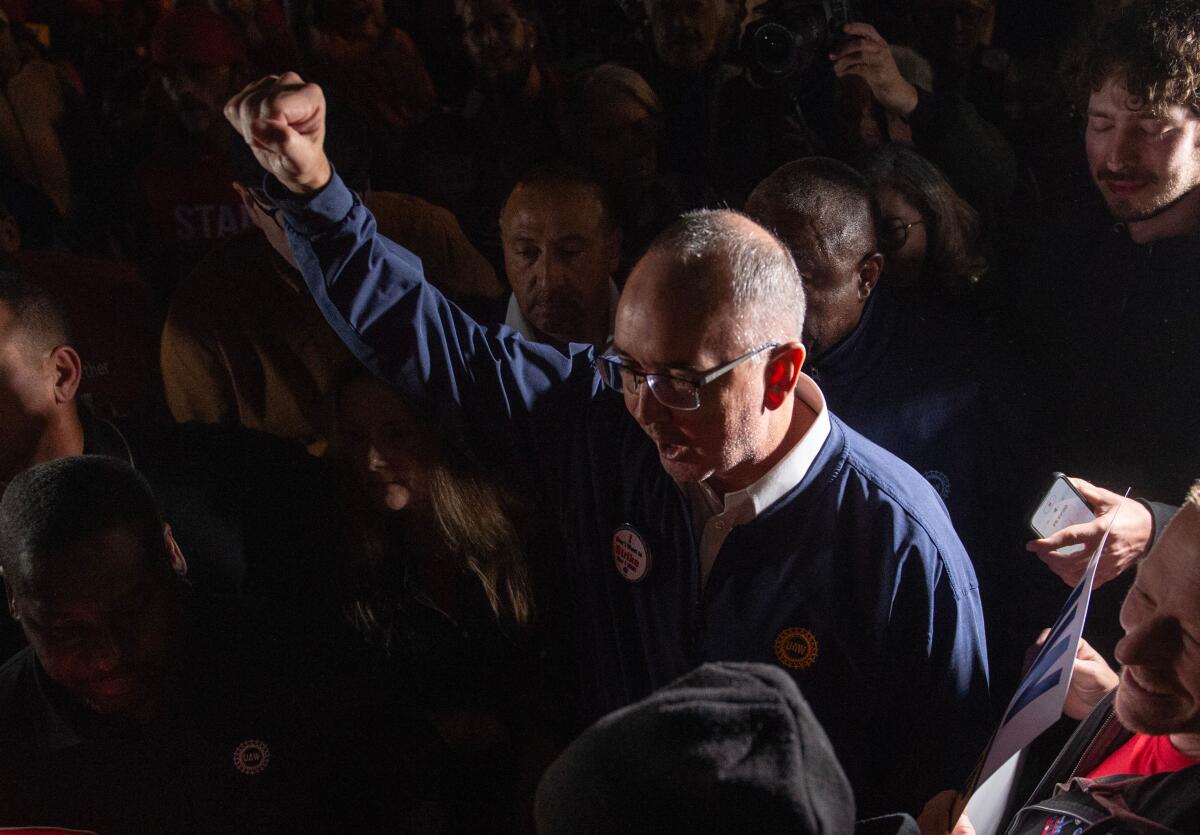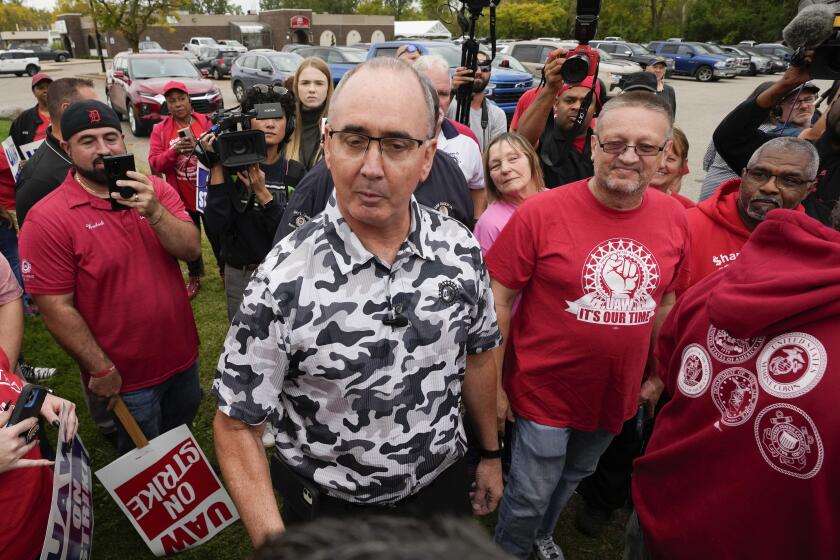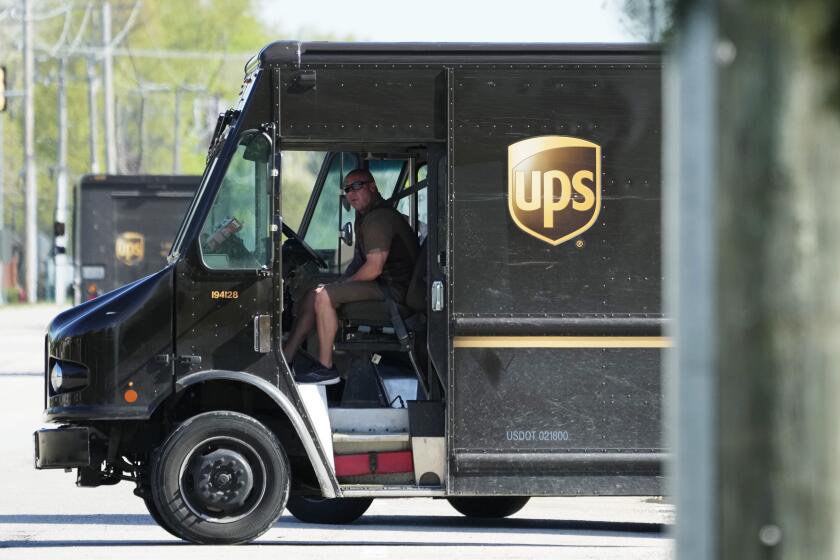Column: Nonunion automakers are matching the UAW’s great contract, but that may be bad for the UAW

- Share via
A funny thing happened in the wake of the United Auto Workers’ recent contract settlements with major auto companies .
Toyota said it would give its workers a raise worth about 9% on its top pay rate, beginning in January.
Nissan said its 9,000 U.S. workers would get raises of about 10% and it would end a two-tiered pay system.
When we return to the bargaining table in 2028, it won’t just be with a Big Three, but with a Big Five or Big Six.
— UAW President Shawn Fain
Honda announced a pay raise of 11% for workers at its plants in Ohio, Indiana and Georgia, along with an accelerated schedule of bringing workers up to the top rate to three years from six.
Subaru said it would raise pay at its plant in Lafayette, Ind., though it hasn’t said by how much.
Get the latest from Michael Hiltzik
Commentary on economics and more from a Pulitzer Prize winner.
You may occasionally receive promotional content from the Los Angeles Times.
What’s funny about these announcements is that none of these companies is covered by a UAW contract. But they could read the handwriting on the wall from the UAW’s contract settlements. If they didn’t, UAW President Shawn Fain made sure they wouldn’t miss the message.
As some of the leading nonunion shops in the industry, they responded almost instantaneously. Before the ink had dried on the union’s agreements with GM, Ford and Stellantis (the owner of Chrysler and Jeep), Fain announced that his next targets would be the foreign automakers that had set up their shops in anti-labor states to keep unions from their doors.
“One of our biggest goals coming out of this historic contract victory is to organize like we’ve never organized before,” Fain said. “When we return to the bargaining table in 2028, it won’t just be with a Big Three, but with a Big Five or Big Six.” (He also signaled that he would be pushing to unionize Tesla.)
There are a few ways to look at this. One is that the UAW has absorbed the lesson that the key to organizing new locations and recruiting new members is achieving victory in contract negotiations. That’s what brings union membership out of the abstract and makes its benefits concrete.
The UAW’s great new contracts with GM, Stellantis and Ford show that union solidarity and concrete goals bring major victories for workers for the first time in decades.
Few things spell success like the contract terms reached by the UAW after its six-week strikes in September and October — including historic wage gains, the rollback of many concessions the union gave the companies to ensure their survival during the last recession, and assurances that the industry’s transition to electric vehicle manufacture won’t proceed without union participation. As far as that goes, the new contracts are a great advertisement for the virtues of union membership.
The improved wage scales and other workplace benefits announced by the Japanese automakers are, of course, good for those companies’ employees, who become collateral beneficiaries of the UAW’s efforts.
It’s also true, however, that the nonunion companies’ responses could successfully undermine the UAW’s organizing efforts.
“When you have a half-unionized industry where the unions have real ability to make a difference, the nonunion companies have to follow along or they are just inviting the unions in,” labor historian Erik Loomis told me. “It becomes very easy to siphon off union support in a factory when the wages are the same plus the workers don’t have to pay dues.”
Indeed, the technique of fighting unionization by offering workers better pay and benefits is as old as, well, labor-management relations themselves.
In his 1993 memoir “Confessions of a Union Buster,” former anti-union consultant Martin Jay Levitt related “the five key corporate failings that drive workers to seek union help,” as his very first boss outlined for him: “Lack of recognition, weak management, poor communication, substandard working conditions, and non-competitive wages and benefits.”
If a company dealt with these issues, Levitt was instructed, “it can achieve a happy work force and never have to fear a union invasion.”
None of that means that the raises announced by Toyota et al. are, or should be, the equivalent of everything a union can offer workers at an organized plant or company.
There may be other benefits that aren’t offered by the nonunion employers, including job security guarantees — especially in anti-union right-to-work states where many foreign automakers and some domestic manufacturers have set up shop, such as North and South Carolina, Indiana, Alabama, Tennessee, Kentucky, Kansas and Georgia.
Strikes against Starbucks stores get all the publicity, but a mass strike by UPS workers could be the turning point for American labor.
Nor should it escape workers’ notice that the nonunion companies had to be goaded by the UAW’s success into offering raises to their own employees.
“Why not the raise before the UAW’s?” asks veteran union lawyer Thomas Geoghegan. “It should tell autoworkers at Toyota, Honda and Subaru, who had nowhere else to go anyway, that they were being paid less than they were worth.”
The companies’ motivation may be to keep the UAW from storming their gates, Geoghegan says, “but it may backfire by making the workers wonder why a raise now, and not before. We don’t have truly competitive labor markets, paying people what they are worth — if we did, then that raise would have occurred without the UAW.”
In other words, the UAW and other heavy industry unions such as the Teamsters have a ways to go to reinforce their recent victories by carrying their fight to new plants in parts of the country — such as the Deep South — where they have long struggled to make headway.
They have a lot to show for their efforts thus far, and for at least the next year, an administration in Washington that has supported Americans’ collective bargaining rights like no other administration in 90 years. At the moment, they appear to have the advantage over recalcitrant managements. Let’s see what they do with it.
More to Read
Get the latest from Michael Hiltzik
Commentary on economics and more from a Pulitzer Prize winner.
You may occasionally receive promotional content from the Los Angeles Times.













